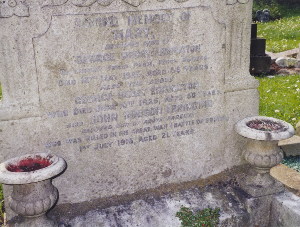
Lumley Churchyard
In Christ Churchyard is a family headstone which reads:
In loving memory of
Mary
Beloved wife of
George Henry Errington
of Lumley Forge Farm Fence Houses
died 16th May 1925 aged 60 years
Also the above
George Henry Errington
who died June 10th 1926 aged 80 years
also of John Robson Errington
beloved son of above parents
who was killed in the Great War (Battle of Somme)
1st July 1916 aged 21 years.
John was born at the beginning of 1895, at Ovington, on the north bank of the Tyne in Northumberland. His parents were George Henry Errington, who was a Blacksmith and later became a Farmer, born in Bellingham, and Mary (nee Robson) who was born in Stocksfield which lies on the south bank of the Tyne just over from Ovington. John's father George Henry was registered as a Blacksmith and the owner of Laudster? Pit in the 1891 census. George Henry learnt his trade of Blacksmith from his father John who was a Master Blacksmith.
John was christened in Ovington on 16th March 1895, receiving his mother's maiden name as his middle name.
Not long after John's birth the family moved to Lumley Forge Farm at Breckon Hill. His younger sister Isabella Ellen was born there at the end of 1896 and a brother George two years later. In 1901 John was living on the farm with his parents and siblings. His father was working as a Farmer and Moulder in the Blacking Factory at Breckon Hill.
In 1911 the family were still living at Lumley Forge Farm, Breckon Hill and John was working on the farm.
When John enlisted with the Durham Light Infantry at Durham on 17th September 1914, he was aged 19 years and 8 months and working as a Farmer. He joined the 18th Durham Light Infantry (Service) Battalion, C Company (Service No. 18/487) at Cocken Hall on 25th September. The 18th Battalion of the Durham Light Infantry was raised in Durham as a "Pals" battalion by Col. R. Burdon and a committee. Formed at Cocken Hall on 10th September 1914 it moved in December to Fencehouses, then back to Cocken Hall in February 1915 and to Fencehouses again in March. In May 1915 they moved to Cramlington then Ripon and came under orders of 93rd Brigade in 31st Division and went to Fovant in September 1915.
In May 1915 the 18th DLI which was attached to 93rd Brigade, 31st Division set sail from Liverpool for Alexandria, Egypt on 6th December 1915 to defend the Suez Canal, arriving on the evening of 17th December. The division was transferred to France for the preparation for the Battle of the Somme in July 1916, arriving on 11th March 1916 at Marseilles.
The 31st Division took over the front line opposite the village of Serre on 31st April 1916, the northern most point of the Somme line. On the morning of the 1st of July D Company of the 18th DLI were in the first wave of the attack and were situated to the southern edge of the village of Serre. The name of Serre has come to be linked closely with several of the 'Pals' battalions, which suffered very heavy losses in the attacks made here.
Along with the 15th and 16th West Yorks, they suffered heavy losses but a few men of D Company managed to reach their objective, Pennant Copse. The other companies of 18th DLI (including John's C Company) were in the second wave with the 18th West Yorks but made no headway and were held in reserve.
On the bloodiest day in British military history, 1st July 1916, the DLI 18th Battalion were heavily involved in the fighting at the Battle of the Somme, going into action and suffering heavy casualties when they supported the Leeds and Bradford Pals.
John was one of the casualties on 1st July 1916. He died of wounds shortly after receiving them, and is buried at Euston Road Cemetery, Colincamps, France.
The 31st Division suffered 4,500 casualties out of the 7,000 who took part in the first day of the battle. Colincamps and "Euston", a road junction a little east of the village, were within the Allied lines before the Somme offensive of July 1916. The cemetery was started as a front line burial ground during and after the unsuccessful attack on Serre on 1 July, but after the German withdrawal to the Hindenburg Line in March 1917 it was scarcely used. It was briefly in German hands towards the end of March 1918, when it marked the limit of the German advance, but the line was held and pushed forward by the New Zealand Division allowing the cemetery to be used again for burials in April and May 1918.
The cemetery is particularly associated with three dates and engagements; the attack on Serre on 1 July 1916; the capture of Beaumont-Hamel on 13 November 1916; and the German attack on the 3rd New Zealand (Rifle) Brigade trenches before Colincamps on 5 April 1918.
The whole of Plot I, except five graves in the last row, represents the original cemetery of 501 graves. After the Armistice, more than 750 graves were brought in from small cemeteries in the neighbouring communes and the battlefields.
John was awarded the 1914-15 Star, British War Medal and Victory Medal.
Research by Michael Bell
John Robson Errington is remembered on Great Lumley G50.01 and G50.02
He is also remembered in The DLI Book of Remembrance page 168
Michael Bell - Facebook Great Lumley
The CWGC entry for Private Errington

